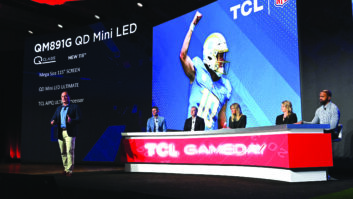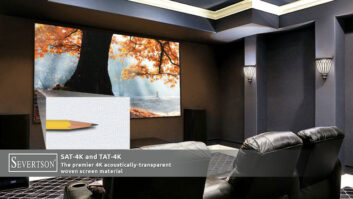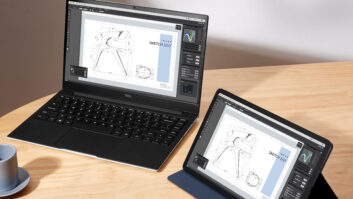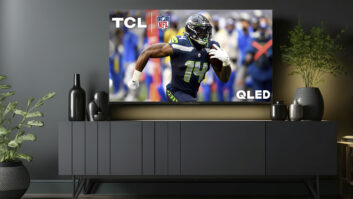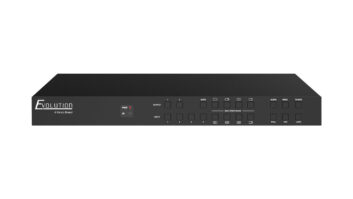TCL will re-enter the Ultra HD 4K TV market in the U.S. this year with seven Ultra HD TVs, including one model featuring color-gamut-expanding quantum-dot and Dolby Vision high dynamic range (HDR) technologies.
That model, the curved-screen 65-inch X1, is targeted for second-half availability, and by that time, the company “is confident” the TV will meet the 4K performance levels specified by the Ultra HD Alliance, including color gamut and minimum HDR range, said Chris Larson, TCL VP of sales and marketing. The TV, featuring a suite of technologies dubbed QUHD, currently delivers “near-100 percent” P3 gamut, he noted.
The TV’s Dolby Vision VS10 HDR technology “will play back a variety of HDR content types, such as Dolby Vision single-layer and dual-layer streams, HDR10 from UHD Blu-ray, and UHD Alliance-certified HDR content,” a Dolby spokesman noted. Positioned as a “universal HDR playback solution,” Dolby Vision combines the ability to play back Dolby Vision content as well as other HDR profiles based on the SMPTE BT 2084 and 2086 standard through one integrated playback solution.” However, the spokesperson added, “it’s up to the TV OEM to make the decision on whether they want to support playback of other HDR profiles and ‘flip that switch on.’”
TCL is using the QUHD moniker to “communicate TCL’s vision for advancing Ultra HD beyond just pixel quantity to pixel quality, including high-dynamic range, wide color gamut and compatibility with new high-dynamic range content being delivered by major content providers,” a spokesperson added.
Other 4K TVs: The other 4K TVs will be the company’s first six 4K TVs running on the Roku TV OS. The company already offers 1080p Roku TVs. The 4K models, all with straight screens, include a 55- and 65-inch model in the US5800 series, which ships in the first quarter. The series is expected to start at less than $600 at retail for the 55-inch model, with the 65-inch model retailing for less than $1,000. In contrast, 55-inch 4K smart TVs retailed mainly around $700 in late 2015, excluding Black Friday, Larson said.
Four other 4K Roku TV models appear in the step-up UP130 series, which ships in the second quarter with more refined cosmetics in 43-, 50-, 55-, and 65-inch sizes. All lack quantum-dot displays and HDR capability. Pricing on the Roku TVs and on the X1 weren’t revealed.
Separately, the company is showing a C2 series of 4K TVs, also with the compay’s QUHD technology suite, including quantum-dot technology and near-100 percent DCI-P3 color gamut. The series isn’t planned yet for North America but will come with some form of HDR capability if it comes here.
A 110-inch 4K TV will also be displayed again like at last year’s CES, but the company has no plans to being it here because “our market position might not support it in the U.S.,” Larson said.
The company also has no plans “at this point” to offer 4K Blu-ray players in the U.S., though the parent company currently makes 1080p Blu-ray players, Larson said.
In other plans, the company will maintain its selection of 1080p Roku TVs at 14.
Here are key details of the 4K launches:
X1: The 65-inch curved-screen X1 will be the company’s first U.S. TV to “show what the TCL brand is capable of,” said Larson, thought the rest deliver a “fantastic experience at a great value.” He added, “We want to be a full-line supplier in the U.S. like we are in the rest of the world.”
To that end, although the X1 is not the company’s first U.S.-market LCD TV with fullarray LED backlighting, it is the company’s first will local dimming, offering 288 zones of local dimming to deliver the potential of Dolby Vision HDR, Larson said. It will also deliver 1,000-nit peak brightness.
The X1 will run a proprietary smart-TV OS, which will be announced in the first quarter with 4K streaming apps, including Vudu, which launched about 18 4K titles with Dolby Vision HDR in late 2015. Only one other streaming service, Amazon, supported HDR on a handful of titles in late 2015, and it used the Open HDR standard.
The X1 will also feature HDMI 2.0a inputs, enabling it to display 4K content in HDR 10 from connected sources such as 4K Blu-ray players and future HDRenabled 4K streamers and settop boxes.
Other key features include 4000R curvature, Harman Kardon speakers, a slim 15.4mm depth, seamless bezel, and quad-core CPU with hexacore GPU.
TCL temporarily dropped 4K TVs in the U.S. in 2015 because it wanted to develop its own smart TV platform for 4K streaming, having previously used Android TV and a Linux-based platform that “did not represent the TCL brand,” Larson said.
Roku US5800, UP 130 series: The straight-screen 55- and 65-inch models, part of the company’s S series, feature Roku TV OS, HDMI 2.0 with HDCP 2.2 copy protection, full-array LED backlighting but not local dimming, and Wi-Fi 802.11 ac dual-band MIMO.
The step-up UP 130 series, part of the P series, offers the same features and adds more elegant cosmetics, voice input via RF remote, and headphone jack on the remote for private listening through headphones. A proprietary RF technology is used to transmit audio to the remote.
Via voice, consumers can search for programs and ask for movies with certain actors, Larson said. Voice control of input switching is not supported.
The Roku Smart TV platform accesses all of the streaming audio and video services streamed by Rou’s settop streaming players, including more than 300,000 TV episodes and movies on more than 3,000 streaming channels. The Roku TV platform is also promoted as simplifying content selection by putting all video sources — TV, Roku streaming services, and connected sources such as game consoles — on a home-screen UI.




